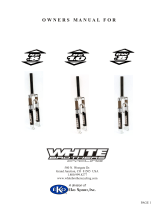removal and service of the fork’s internals and
removal of the leg from the top crown. It should
not be necessary to loosen or remove this upper
collar. On the Lefty ELO, this upper collar should
be removed only to change the battery in the
electronic control unit. If the upper collar is
loosened or removed, it should be reinstalled
with a drop of Loctite 242 (blue) on the threads
and torqued to 250 In-Lbs (28 Nm).
INNER STANCHION TUBE
Several times a year, or if the suspension boot
has been damaged, or if the fork has taken a
large or unexpected impact, you should
inspect the inner stanchion tube beneath the
boot. Before proceeding, make sure that you
have two replacement zip ties to reaffix the
HeadShok boot. These should be available
from your local Cannondale or HeadShok
Authorized Retailer. Cut both old zip ties off
of the boot and pull the boot up off of the
lower boot mount and down off of the lower
collar. Clean this area inside the boot of any
dirt and old grease. Inspect the inner races
and the stanchion tube for corrosion, cracks,
or a bent leg.
If there are any cracks on the telescoping
assembly or if it is bent at all, the fork must
be replaced immediately. DO NOT CONTINUE
TO RIDE THE FORK! See your local
Cannondale or HeadShok dealer.
If rust, pitting, or corrosion is present on the
inner leg, you should take the fork to your
Cannondale Authorized Retailer for inspection.
They will assess the condition of the fork and
evaluate the amount of structural damage that
may have resulted.
WARNING: Serious, structural corrosion on
the telescoping assembly of a HeadShok fork will
decrease the useful life of the fork. Corrosion or
cracks on the stanchion tube, or a bent stan-
chion tube, may lead to the failure of the fork,
which could cause an accident with attendant
risk of injury or death to the rider. HeadShok
forks that show signs of such structural damage
in the telescoping assembly must be replaced
immediately.
After completing the inspection of the
HeadShok steerer tube assembly lightly coat
the exposed length of the inner steerer tube
and bearing races with a good quality light
bicycle grease, such as Royal Purple grease,
Finish Line White Teflon grease, or Slick 50
One Grease. Replace the boot onto the lower
collar of the HeadShok telescoping assembly
and to the bottom of the inner fork tube.
Reattach the boot with two zip ties. Make sure
that the zip ties are secured tightly.
NEEDLE BEARING LUBRICATION
The needle bearings (which provide the
smooth travel of the HeadShok sus-pension
system) inside all mountain HeadShok forks
should be lubricated every two months or 40
hours of riding. This procedure requires partial
disassembly of the suspension fork, and there-
fore must be performed only by an experi-
enced bicycle mechanic at an Authorized
HeadShok Service Center.
CARTRIDGE SERVICE AND CUSTOM TUNING
The HeadShok system is incredibly versatile
and can be easily adjusted or upgraded.
Depending upon the model of fork, HeadShok
Service Centers can advise you about changing
spring preload, spring rate, compression
damping, rebound damping, and on-the-fly
lock out. See your dealer for more informa-tion
regarding the fine-tuning or upgrading of your
HeadShok Lefty fork.
Like other HeadShok damping cartridges, the
Lefty ELO and DLR cartridges can be
removed, serviced, adjusted, bled, and rein-
stalled. The ELO and DLR cartridges come
stock with 5 weight oil. This can be changed
to a lighter or heavier fluid for decreased or
increased fork damping. Additionally, the
damping characteristics can be modified by
changing the internal valve shims on the oil
piston. The shims on top of the piston control
compression damping, while the shims under
the piston control the rebound damping.
Thicker shims provide more damping. These
service procedures should only be performed
by an experienced bicycle mechanic at an
Authorized HeadShok Service Center.
WASHING THE ELO
A note on the washing of a Lefty ELO fork:
Because of its electronic compo-nents, some
care must be taken when washing an ELO
equipped bicycle. The electronic control unit
is sealed to resist penetration of water and
mud when riding, but is not water proof. The
ELO unit should not be totally submerged in
water, nor should a high pressure water spray
be directed at the unit. The best way to thor-
oughly wash the Lefty ELO is to use a damp
sponge or rag and a little detergent if neces-
sary.
12















